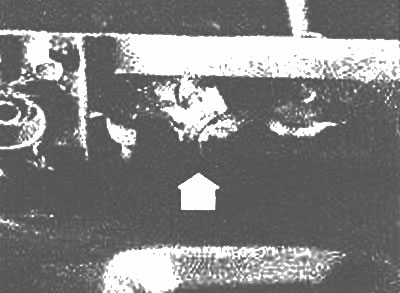2. When servicing the cooling system, all hoses and radiator cap should be inspected and replaced if defective (see chapter 7).
3. Since antifreeze is aggressive to paint and poisonous, do not allow coolant to come into contact with the painted surfaces of the car or your skin. If this does happen, wash off spilled drops with plenty of clean water.
4. Remove the radiator cap (engine must be cold).
5. Place a large container under the radiator to collect the drained coolant.
6. Drain the radiator by removing the drain plug located at the bottom of the radiator (photo). If the plug is rusty and cannot be removed, or if the radiator is not equipped with a drain plug, disconnect the lower hose from the radiator and drain the fluid. Be careful not to splash the mixture on your skin or eyes.

The drain plug is located at the base of the radiator
7. Disconnect the hose from the coolant reservoir and remove the reservoir. Rinse it with clean water.
8. Connect a garden hose to the radiator filler neck and flush the system until clean water flows from all open holes. If, after a considerable period of time, the water flowing out is still dirty, flush the radiator with a good special cleaner such as Holts Radflush or Holts Speedflush. Follow the product manufacturer's instructions exactly.
9. If the radiator is seriously dirty or clogged, remove it (see Section 3), turn over and rinse in reverse. To do this, insert the hose into the radiator base connection and let the water run in the opposite direction to the normal flow. If further cleaning or repair of the radiator is necessary, contact a workshop.
10. If the cooling system is maintained regularly and the system is filled with a mixture of the correct proportion of antifreeze, water, there should be no need to use chemical cleaners.
11. To fill the system, reconnect the radiator hoses and install the expansion tank and its hose.
12. Fill the radiator to the base of the filler neck, then add coolant to the reservoir until the level reaches the bottom mark (photo).

Filling the radiator
13. Start the engine, warm it up to normal operating temperature and with the engine idling, bring the coolant level to the mark «Full». Install expansion tank and radiator caps.
14. Monitor the coolant level during the first kilometers of run. Tighten the hose clamps and/or add coolant as needed.
